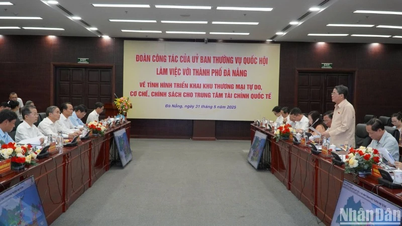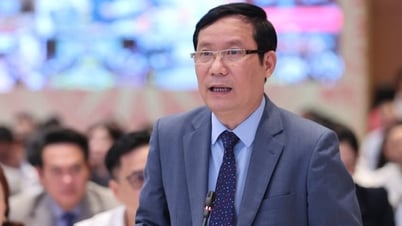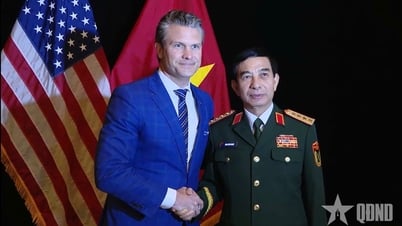US and Ukraine finalize deal
On April 30, 2025, the US and Ukraine officially signed a mineral exploitation agreement with the US, marking a turning point in bilateral relations and the regional geopolitical situation.
The agreement, signed in Washington by US Treasury Secretary Scott Bessent and Ukrainian First Deputy Prime Minister Yulia Svyrydenko, is now awaiting ratification by the Ukrainian parliament .
On Telegram, Ukrainian Prime Minister Denys Shmygal noted that Kiev would retain “full control over underground resources, infrastructure and natural resources.” Meanwhile, US President Donald Trump believes that the US will receive more than $350 billion. This is the amount that Mr. Trump once mentioned about the total value of US aid to Ukraine. But there are different figures on the total value of aid.
According to Mr. Shmyhal, future military aid from the US side could be counted as part of the contribution to the fund, but previous aid would not be counted.
The agreement stipulates that the two sides will jointly exploit mineral resources in Ukraine, with revenues going to a “Reconstruction Investment Fund” jointly managed by Washington and Kiev. According to Mr. Shmyhal, this fund will attract large resources for the country’s reconstruction, promote economic growth and access to advanced technology from the United States.
Mr. Bessent also confirmed that the mineral agreement is a clear message emphasizing that the US will pursue a long-term peace agreement, affirming the "long-term strategic alignment" between the US and Ukraine as committed by Mr. Trump. The US is committed to supporting Kiev's security, prosperity and global economic integration.
However, the document does not provide specific security guarantees, an element that President Volodymyr Zelensky had hoped to use to deter Russia in the future.
For many experts, the US-Ukraine mineral deal not only opens up economic opportunities for both sides but also reflects President Donald Trump's efforts to ensure the supply of essential minerals for the US, reducing dependence on China.
The agreement reached on April 30 was the result of several rounds of intense negotiations between the United States and Ukraine, and one notable failure. Since the beginning of his second term, President Trump has been putting strong pressure on Ukraine to reach a mineral exploitation agreement.
In early February 2025, he sent Treasury Secretary Scott Bessent to Kiev to negotiate with Ukrainian President Zelensky, then publicly pressured Ukraine to sign.
Initially, the US demanded that Ukraine reimburse $500 billion in resource revenues in exchange for military and financial aid, a proposal that Zelensky strongly rejected due to lack of security guarantees and unfair profit-sharing ratios.

The meeting at the White House on February 28 between Mr. Trump and Mr. Zelensky marked the peak of the conflict, when the two sides argued fiercely and failed to reach an agreement.
The US then adjusted, removing the $500 billion requirement and focusing on long-term returns from the joint investment fund. On April 30, after negotiations in Saudi Arabia and Munich, the final agreement was signed, marking a step forward in bilateral relations.
Kiev retains "complete control", what does the Donald Trump administration get?
The US-Ukraine mineral deal was signed amid a three-year-long Russia-Ukraine conflict that has taken a heavy toll on Kiev and complicated US-EU-Russia relations. Mr. Trump, who campaigned on a promise to end the conflict quickly, sees the mineral deal as a lever to achieve a dual goal: securing economic benefits for the US and promoting peace negotiations.
Mr. Trump said that aid to Ukraine was "unfair" and needed to be compensated with resources, especially rare earths, on which the US depends heavily on China.
US-EU relations have been strained by concerns in Europe that Ukraine will become too dependent on the US, weakening the EU’s role in the region. Meanwhile, Russia has many reasons to be wary of the mineral deal. Moscow also holds the advantage of controlling a portion of the resources in eastern Ukraine, which it can exploit or deny the US access to.
Mr. Trump, with a vision from his first term (2017-2021), signed an executive order to ensure a secure supply of essential minerals, avoiding dependence on China - the country that controls most of the global production and processing of rare earths. The idea of taking over resources from other countries such as Greenland or Canada has been mentioned by Mr. Trump, but Ukraine, with its mineral reserves worth $12 trillion, has probably become a strategic target.
The U.S.-Ukraine minerals deal is seen as a strategic opportunity for the United States to reduce its dependence on China in the supply chain of rare earths and critical minerals. Ukraine holds about 5% of the world’s mineral reserves, including titanium, lithium, manganese, and rare earths. These are important materials for military technology, electric vehicles, and artificial intelligence (AI) data centers – areas that Mr. Trump has made a priority in his second term.
In addition, the joint investment fund allows the US to control a significant portion of the revenue from Ukrainian resources, ensuring long-term economic benefits. Mr. Trump also achieved a political victory when the agreement helped "recover value" from previous aid, fulfilling his promise to voters to reduce the cost of foreign assistance.
Ukraine is seen as Europe’s “mineral treasure trove.” The deal gives Ukraine reconstruction funding, advanced technology from the United States, and the opportunity to integrate into the global economy. Kiev also retains control of underground resources, avoiding the scenario Zelensky feared.
However, the actual economic benefits may be limited because it is not easy to exploit commercially. Ukraine also has to share 50% of the revenue, while receiving no specific security guarantees, making Kiev heavily dependent on US goodwill.
For Russia, the deal raises the risk of the United States consolidating its influence in Ukraine, especially if Washington takes more aggressive steps. But Moscow still has the advantage of controlling the eastern mines, which it can exploit or block. Russia could also benefit indirectly if the deal spurs peace talks.
The EU is concerned that Ukraine will become more dependent on the US, weakening its role in the region. The EU has previously proposed a separate mineral deal with Ukraine that would be “mutually beneficial” and would not require unequal profit sharing. The EU could lose direct access to Ukrainian mines if the US prevails, but it could also benefit if the deal contributes to regional stability.
The US-Ukraine mineral deal is seen as a multi-pronged move by Mr. Trump, meeting the economic and geopolitical interests of the US while strengthening support for Ukraine. However, with the lack of security guarantees and competition from Russia and the EU, the deal risks causing regional imbalances. Ukraine, despite economic benefits, will still face the challenge of maintaining its sovereignty and long-term security. Meanwhile, Russia and the EU need to adjust their strategies to protect their interests in the context of increasing US influence.

Source: https://vietnamnet.vn/thoa-thuan-khoang-san-my-ukraine-kiev-kiem-soat-chinh-quyen-ong-trump-duoc-gi-2396945.html


























































































Comment (0)